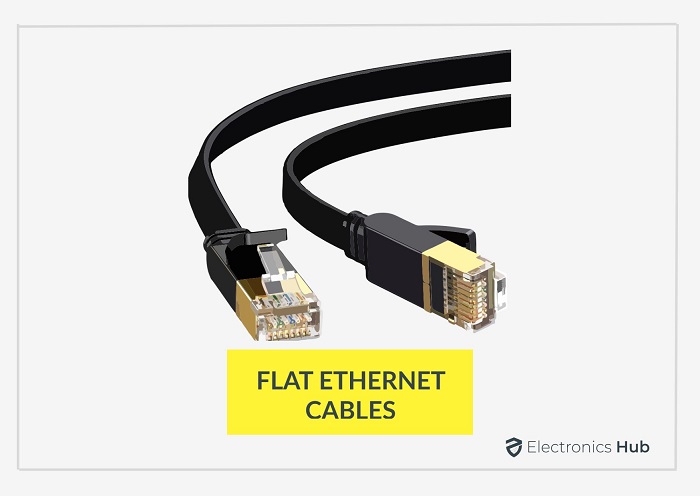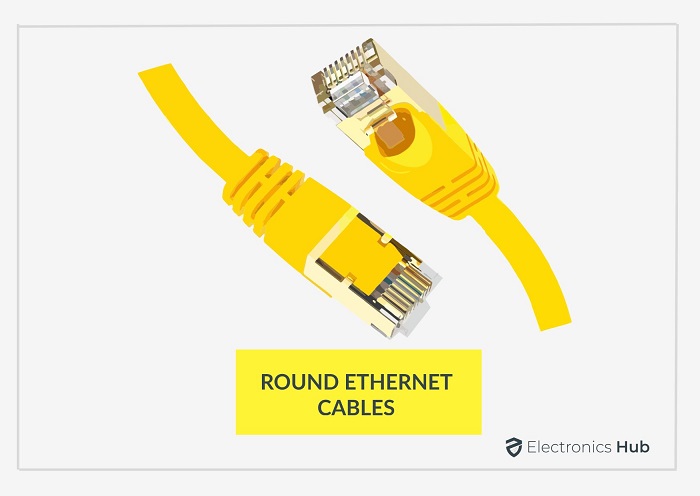When you set up a wired network connection, you use an internet cabling called Ethernet cable. But do you know that Ethernet cables come in flat as well as round shapes? Apart from their difference in design, they differ in terms of material construction, insulation, and maintenance as well. Hence, they find different applications while setting up a LAN connection for a wired network. Here is everything you need to know about Flat and round Ethernet cable.
Outline
ToggleWhat is Flat Ethernet Cable?

Now, these cables find application in aerospace, robotics, and premium computer-based systems. If there is compact space available, they are ideal. The cables generate less noise and vibration. However, due to lack of insulation, these cables are susceptible to electromagnetic interface.
What is Round Ethernet Cable?

Flat Ethernet Cable vs Round Ethernet Cable: Advantages & Disadvantages
Both the types of Ethernet cables have their advantages and disadvantages. Accordingly, they are used in different industries and sectors.
- Lack of filler substance in flat Ethernet cable generates high noise and cross talk.
- Flat Ethernet cables are easy to handle and therefore, they are perfect for under carpet or floor cables.
- Round Ethernet cable has insulation and prevents interference.
- Flat Ethernet cables are suitable for tight bends but they are comparatively pricey.
Differences Between Flat and Round Ethernet Cables
1. Cable Design
Flat cables do not include any protective filler. They are perfect for electrical quality and remain constant with one another. Compared to round cables, it requires more maintenance. However, it does have reduced weight and volume as it does not come with low friction wires. Flat Ethernet cables are also pocket friendly in comparison to round cables.
The structure of round cables contains different layers of wires along with additional components. This helps to reduce the internal heat. It further helps to increase durability and offer a high level of operational performance. Round cables are also very flexible that making them easily fit into tight spaces.
2. Maintenance
Since flat cables are for permanent installation, they require more maintenance. This makes them offer reduced up time when compared to round cables. In contrast, round cables offer more uptime with less maintenance.
3. Insulation
Flat Ethernet cables do not come with any insulation or filler that are available in round cables. However, it does have similar insulation as in electrical properties. This means that it is much vulnerable to electromagnetic interferences. It can happen particularly during long distances.
If you compare it with round Ethernet cables, they come with more insulation. It helps them offer better protection against EMI. The shielded design also helps to offer long lasting performance. The conductors help to maintain the strength of the cable while running in a parallel route.
4. Attenuation
In flat Ethernet cables, the attention can be often worse. It can happen as it increases the chances of electromagnetic interference which makes it suffer from attenuation. It is very unsuitable for long distances.
Even over long distances, round Ethernet cables are not prone to attenuation. It makes them perfect for long distances as there is no degradation of data. The thick insulation helps to provide better protection against EMI.
5. Installation
Talking about installation, flat Ethernet cables can be a great choice when you happen to install them on the carpet. Their flat structure allows them to have better adaptability on different surfaces including ground.
However, round cables offer better convenience as you don’t have to deal with any hassle. The solid core wiring makes it a reliable choice for long-distance cabling. You must always look for a solid round cable when you happen to pass them through walls. Round cables also offer better insulation and protection.
6. Overall Execution
The electrical conductor quality offered by flat cables is constant. It makes sure that the physical strength remains the same while using. Flat cables can be great for limited spaces even though it requires more maintenance compared to round Ethernet cables.
Round cables are more durable as it has multiple layers of insulation and other wires. The structure also makes them perfect for data centers. Additionally, it has the ability to reduce heat generation from the inside due to the repetition of wires.
7. Cost
As round Ethernet cables have a complicated structure and more components, it is higher in cost compared to flat cables. Even if they happen to be of the same length, round cables are more expensive. In case you are looking for a pocket-friendly round Ethernet cable, you need to look for a suitable alternative.
Conclusion
Both the types of Ethernet cables have their merits and demerits. If you are going to use Ethernet cable for your home and office in a wired network, you should use round Ethernet cable. Moreover, most commercial applicable prefer flat cables where there is a lesser chance of interference.

